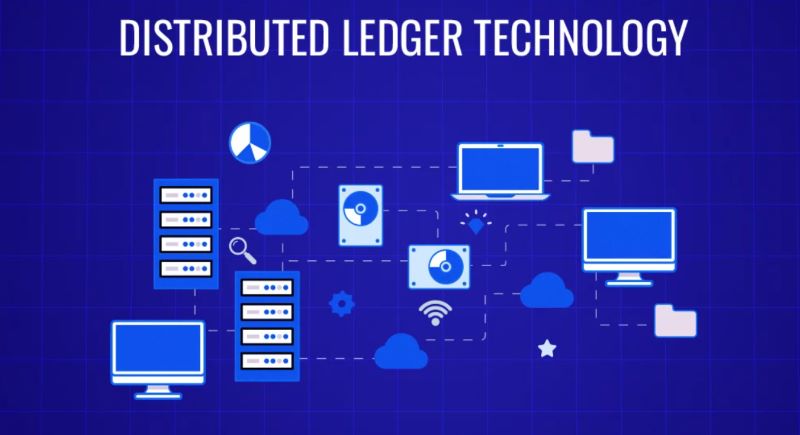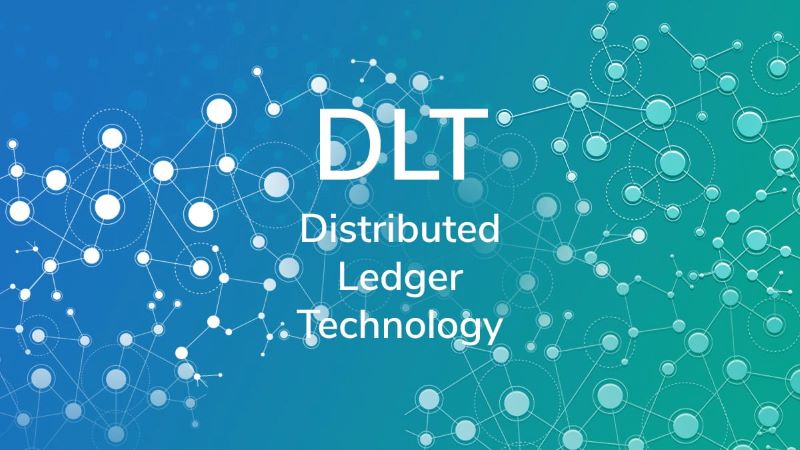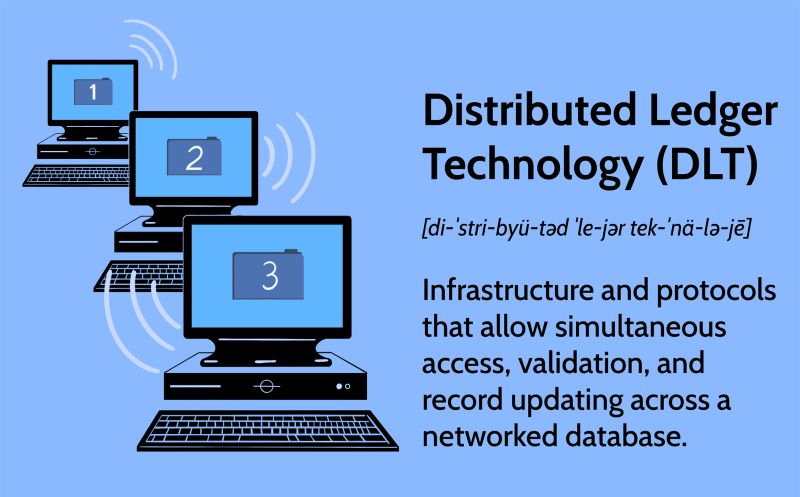Have you ever wondered about the difference between Distributed Ledger Technology vs blockchain? In today’s groundbreaking tech landscape, these terms are often used interchangeably. Join us as we uncover their unique features and exciting applications, and discover how each one shapes our digital future!
Comparing Distributed Ledger Technology vs Blockchain

Data Structure
- Blockchain: Blockchain is a specific type of DLT that uses a chain-of-blocks data structure. Each block contains a set of transactions and is linked to the previous block using a hash function. This creates a continuous and immutable chain from the first block to the current one.
- DLT: DLT is not limited to the blockchain structure. DLT can utilize various data structures, such as DAG (Directed Acyclic Graph) in IOTA technology. These data structures can be more flexible to suit the specific needs of different applications.
Decentralization and Security
- Blockchain: Blockchain typically operates on a decentralized model, where every node in the network has a copy of the entire blockchain. This ensures high security and transparency, as every transaction is verified and stored on multiple nodes.
- DLT: DLT can implement different decentralization models. Some DLT systems do not require all nodes to have a full copy of the data, but only require transaction validation through a selected number of nodes. This may reduce trust but can provide flexibility in network design.
Scalability and Performance
- Blockchain: Blockchain often faces scalability challenges because each transaction must be validated and added to the blockchain sequentially. This can lead to congestion and longer transaction processing times as the network grows.
- DLT: DLT can offer better scalability due to its various data structures and distributed transaction models. For example, DLT systems using DAG have the ability to process transactions concurrently and can mitigate network congestion issues.
Cost and Efficiency

- Blockchain: The cost and efficiency of blockchain can be high because the entire blockchain needs to be maintained and synchronized across all nodes. This often requires significant computational power and can lead to high transaction fees.
- DLT: DLT can help reduce costs by using different validation models and reducing the demand for energy and system resources. This can make DLT applications more cost-effective and resource-efficient.
Real-World Applications
- Blockchain: Blockchain is commonly used in applications that require high transparency and trustworthiness, such as cryptocurrencies (Bitcoin, Ethereum) and smart contracts. These applications demand high security and immutability of information.
- DLT: DLT can be applied in various fields, including supply chain management, internal payment systems, and other financial applications. DLT systems like IOTA can be used in IoT (Internet of Things) applications due to their improved scalability and performance.
With the differences between Distributed Ledger Technology vs Blockchain, we can clearly and favorably orient the future.
Future Prospects of Distributed Ledger Technology vs Blockchain

Prospects of Blockchain
- Expanding Applications: Blockchain continues to expand its applications beyond the cryptocurrency realm. Smart contracts and decentralized applications (dApps) are becoming increasingly popular in industries such as finance, insurance, and real estate. The development of platforms like Ethereum and Polkadot is making blockchain scalability and integration more practical.
- Improved Performance and Scalability: Research and development continue to focus on addressing blockchain’s scalability challenges. Solutions like sharding, the Lightning Network, and new protocols like Ethereum 2.0 promise to improve transaction processing capabilities and reduce costs.
- Increased Regulation and Legitimization: With growing attention from regulatory bodies and governments, blockchain is gradually gaining wider acceptance, and we can expect to see the development of more specific regulations. This will help enhance transparency and protect users, while also supporting the sustainable growth of the blockchain industry.
Prospects of Distributed Ledger Technology (DLT)
- Increased Application Diversity: DLT is not limited to blockchain but also encompasses technologies like DAG (Directed Acyclic Graph) and other data structures. This allows DLT to expand beyond current applications to cover more fields, from supply chain management to the Internet of Things (IoT).
- Optimized Scalability and Performance: DLT can offer alternative solutions to blockchain to address scalability issues. For example, technologies like IOTA use DAG to improve concurrent transaction processing and reduce transaction costs. This will drive the adoption of DLT in industries that require large-scale data processing and real-time capabilities.
- Integration into Enterprise and Government Systems: DLT is becoming an essential tool in improving business processes and government systems. DLT solutions can help enhance transparency and efficiency in data management and workflows. For instance, supply chain management and asset registration systems can be significantly improved by adopting DLT.
Recommendations for Harnessing the Value of Distributed Ledger Technology vs Blockchain

To harness the value of Distributed Ledger Technology vs Blockchain, the following suggestions can be considered:
Understand the Technology Thoroughly
- Fundamental Research: Before adopting, gain a solid understanding of the basic concepts of both DLT and blockchain. Understanding their differences will help you choose the most suitable technology for your specific needs.
- Explore Real-World Applications: Examine real-world use cases to see how each technology can be applied in your industry.
Choose the Right Technology
- Assess Your Needs: Identify the requirements of your project or business, including factors like scalability, security, and cost. Blockchain might be more suitable for applications requiring high data integrity, while DLT could be a better choice for applications needing high transaction processing capabilities.
- Consider Compatibility: Choose a technology that aligns with your existing systems and can integrate with other solutions in your ecosystem.
Focus on Security and Regulation
- Ensure Security: Make sure the technology you choose meets the necessary security standards to protect data and transactions. Review built-in security measures and encryption methods.
- Comply with Regulations: Be aware of regulations regarding the use of DLT and blockchain in your field. Ensure you adhere to legal requirements and industry standards.
Optimize Performance

- Evaluate Performance: Monitor the technology’s performance in practice and make adjustments as needed. New technologies may require optimization to achieve maximum performance.
- Continuous Improvement: Continuously update and improve your solutions based on technological advancements and user feedback.
Invest in Training and Development
- Train Your Staff: Ensure your team is trained in DLT and blockchain technologies to optimize deployment and usage.
- Support Development: Support the development of DLT or blockchain-based applications and solutions by collaborating with experienced professionals and developers.
Stay Updated on Trends and Innovation
- Track Trends: Stay informed about new technology trends and advancements in DLT and blockchain to avoid missing out on new application opportunities.
- Experiment and Innovate: Continuously experiment with new solutions and innovate to maximize the potential of the technology.
The analysis of “Distributed Ledger Technology vs Blockchain” highlights the distinct characteristics and applications of these technologies. While blockchain provides a specific implementation with a linear, immutable chain of blocks, distributed ledger technology blockchain offers a broader range of structures and use cases. Understanding these differences is crucial for leveraging their respective strengths in various domains.
For more insights and detailed coverage on this topic, you can refer to Blockchain Global Network.

RELATED POSTS
Physical Bitcoin: The truth about the top digital currency
Have you ever heard of...
Crypto Crashing and 3 important investment implications
Crypto Crashing has shaken the...
Fishwar Airdrop – Play to Earn on the Sei Blockchain
Fishwar Airdrop, a prominent project...
Is Ledger open source? 95% of Ledger’s software is open source
Wondering “Is Ledger open source?”...
What is Particles? Exploring the details of the project
In the rapidly growing blockchain...
Key blockchain developments expected by august 2025
As we look towards the...
ICMP Protocol: Important protocol in network management
The ICMP Protocol (Internet Control...
Explore Top DePin AI Projects
Exploring the leading DePin AI...
Hana Network Airdrop – Detailed Guide to Receiving Tokens
This detailed guide will help...
Don’t miss out on the DogX, Airdrop to X users
“DogX, Airdrop to X users”...
Mapping Opportunities with Funding Rate Heatmap
In the fast-paced trading world,...
Blockchain Technology News Update – HOT Trends for 2025
Blockchain technology news is abuzz...
Hop Airdrop: A detailed guide on how to participate
Hop Airdrop is a free...
Kuroro Beasts: An engaging NFT Game on Ronin
Kuroro Beasts – An NFT...
Guide to Hunting the Ithaca Airdrop – From Testnet to Success
From the initial steps on...
What happened to MOVE Coin? Market Trends, Challenges, and Future Outlook
What happened to MOVE Coin?...